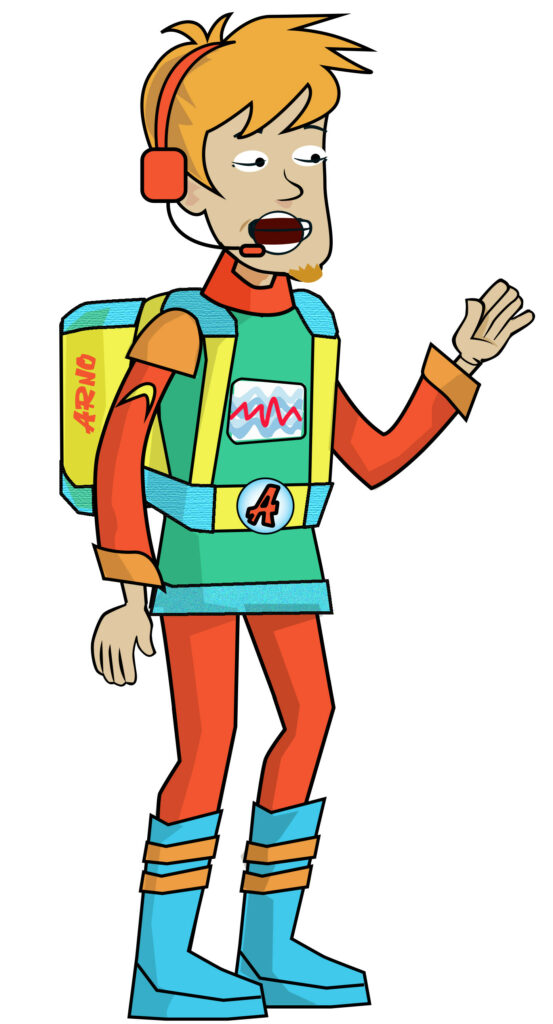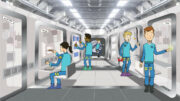
Every day in the UK, over 11 billion litres of waste water from homes, schools and places of work, are collected by 340,000 kilometres of sewers. After being treated at one of 9,000 sewage treatment works, it’s discharged into our rivers and the sea. Without suitable treatment, waste water would damage the environment, harm wildlife and create public health problems.

Hi. I’m Arno. I’m with the Aquanauts.
We’re wild about water and how to make sure there’s enough for everyone who needs it now and in years to come.
Here at Aquanaut HQ, we’re checking out how water gets to our taps – from the traditional water cycle to making fresh water from the sea.

What happens to the water once we’ve used it is also incredibly important. It’s time to investigate the murkier side of water – what happens when it swills down the sink or is flushed down the toilet…
Water from washing up, the shower and washing machines is sometimes called waste water.
Aquafact – The term waste water can make it sound like we don’t need it. Another way to describe it is grey water – not clean enough to drink but still important!
When we’ve finished with it, waste water drains into a giant network of underground sewers that takes it and all the nasty stuff it contains to sewage treatment works. Sewers also take away rain and surface water from our streets. Sewers are incredibly important and can get overloaded when there’s a big storm! If there’s too much water in the sewers, it might all be released into our rivers!
Sewage treatment works are like huge biological factories, using technology and micro-organisms to clean up waste water through several cleaning and filtering processes.
The first task is to remove any big objects that should never have gone down the drain in the first place, things like wet wipes, cotton buds and nappies. Putting these in the toilet instead of the bin can cause blockages and cause a lot of mess. Remember… put them in the bin, not down the toilet!
In large settlement tanks solid stuff, mostly poo but also sediment like grit that’s been washed into the sewer, is separated from the water. Solids basically sink to the bottom to form a layer of horrible gunk, called sludge which is pumped away for further treatment.

The water then goes through a series of filters, each removing more and more sediment, before arriving in an aeration tank where air is pumped into the water to encourage micro-organisms, basically teeny weeny bacteria, to break down and eat some of the harmful stuff.
The water is then passed through a final settlement tank where the bacteria sink to the bottom and create more sludge. Then, after one final filter through a bed of sand, the treated water is released back into rivers.
But… what about that yucky sludge?!
Sludge may be icky but it’s very useful. Most goes to farmers who use it to fertilise their crops but we need to be careful. Sludge can still have nasty stuff like microplastics in it, which can be washed back into the rivers by rain if we’re not careful. Sludge can be also used to create electricity!
We’re talking about POO POWER!
Sludge from the treatment tanks goes through anaerobic digesters where it’s heated up, encouraging bacteria to break down the waste, creating a biogas that can be burned to create heat and in turn electricity. An alternative process is to dry the sludge into blocks which are then burned to generate heat. A great benefit of biogas is that it might be a big help in the change to renewable energy sources.
Given that treatment works to clean up the water – can it be clean enough to drink? That would create valuable drinkable water in water-short places, reduce waste and probably be cheaper than desalinating seawater.

Well, there are pioneering solutions to do just that. After wastewater has gone through the standard treatment process, the cleaned water can be put through further treatment before returning to the water supply.
It first goes through micro filtration to remove the smallest particles, then is put under pressure to pass through a membrane which filters out undesirable components such as bacteria, viruses and pharmaceuticals. Once it’s been disinfected using special chemicals and strong UV light, it’s ready to drink.
So, as well as cleaning up our waste water, we can produce renewable energy and also new drinking water. That has to be great for environmental sustainability.
YOU can be an Aquanaut by doing simple things like being super careful not to put anything down the toilet that shouldn’t be there – things like wet wipes or cotton buds.
Or maybe think about a career in water technology…
Water Workers

There’s a wide range of jobs across the water sector, including… Water and Sewage Engineers!
Sewage engineers, also known as wastewater engineers or sanitary engineers, design, build, and manage wastewater treatment systems. They ensure that wastewater is treated properly before being released back into the environment
They design, construct, and maintain systems that treat and dispose of wastewater. They work to keep things safe for the environment and the public.
Take the challenge!
Demonstrate the scale of water usage in everyday activities through this fun (and slightly messy!) physical activity! Ready? Download here!
Want to know more?
‘This is Engineering’ is an initiative led by the Royal Academy of Engineering in partnership with EngineeringUK and major engineering organisations to encourage young people from all backgrounds to consider a career in engineering. Click HERE to find out more… or perhaps visit the Museum of Engineering Innovation.
Stick with us… we’re going to be be helping you understand the challenges ahead, and discover some of the cool engineering and careers that are helping solve the issues. We’re also going to find out how we can all make a difference with more tips on how you can become an Aquanaut and help engineer our water future!




